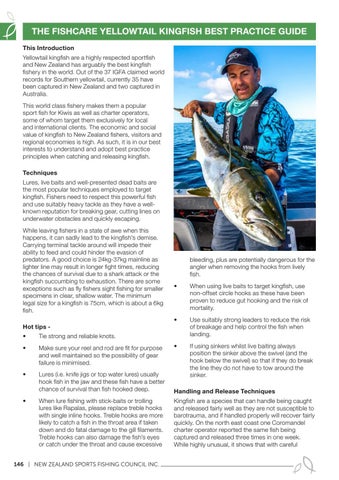THE FISHCARE YELLOWTAIL KINGFISH BEST PRACTICE GUIDE This Introduction Yellowtail kingfish are a highly respected sportfish and New Zealand has arguably the best kingfish fishery in the world. Out of the 37 IGFA claimed world records for Southern yellowtail, currently 35 have been captured in New Zealand and two captured in Australia. This world class fishery makes them a popular sport fish for Kiwis as well as charter operators, some of whom target them exclusively for local and international clients. The economic and social value of kingfish to New Zealand fishers, visitors and regional economies is high. As such, it is in our best interests to understand and adopt best practice principles when catching and releasing kingfish. Techniques Lures, live baits and well-presented dead baits are the most popular techniques employed to target kingfish. Fishers need to respect this powerful fish and use suitably heavy tackle as they have a wellknown reputation for breaking gear, cutting lines on underwater obstacles and quickly escaping. While leaving fishers in a state of awe when this happens, it can sadly lead to the kingfish’s demise. Carrying terminal tackle around will impede their ability to feed and could hinder the evasion of predators. A good choice is 24kg-37kg mainline as lighter line may result in longer fight times, reducing the chances of survival due to a shark attack or the kingfish succumbing to exhaustion. There are some exceptions such as fly fishers sight fishing for smaller specimens in clear, shallow water. The minimum legal size for a kingfish is 75cm, which is about a 6kg fish. Hot tips •
Tie strong and reliable knots.
• Make sure your reel and rod are fit for purpose and well maintained so the possibility of gear failure is minimised. • Lures (i.e. knife jigs or top water lures) usually hook fish in the jaw and these fish have a better chance of survival than fish hooked deep. • When lure fishing with stick-baits or trolling lures like Rapalas, please replace treble hooks with single inline hooks. Treble hooks are more likely to catch a fish in the throat area if taken down and do fatal damage to the gill filaments. Treble hooks can also damage the fish’s eyes or catch under the throat and cause excessive 146 | NEW ZEALAND SPORTS FISHING COUNCIL INC.
bleeding, plus are potentially dangerous for the angler when removing the hooks from lively fish. • When using live baits to target kingfish, use non-offset circle hooks as these have been proven to reduce gut hooking and the risk of mortality. • Use suitably strong leaders to reduce the risk of breakage and help control the fish when landing. • If using sinkers whilst live baiting always position the sinker above the swivel (and the hook below the swivel) so that if they do break the line they do not have to tow around the sinker. Handling and Release Techniques Kingfish are a species that can handle being caught and released fairly well as they are not susceptible to barotrauma, and if handled properly will recover fairly quickly. On the north east coast one Coromandel charter operator reported the same fish being captured and released three times in one week. While highly unusual, it shows that with careful













